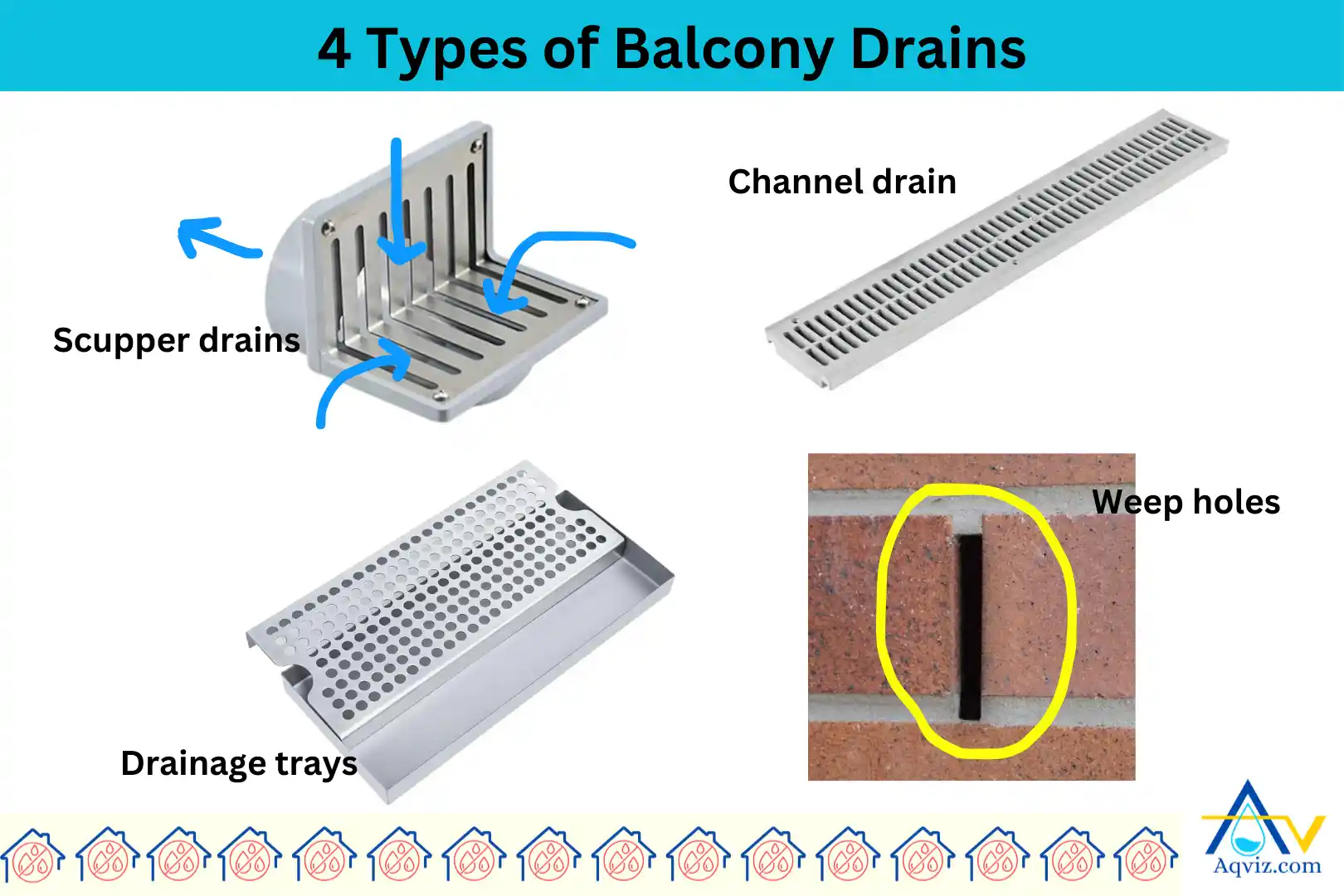Balcony Drainage Regulations, Systems, and Common Problems

Balcony drainage is the system designed to channel rainwater, melted snow, and other moisture away from the balcony surface to prevent water accumulation, structural damage, and leaks. A proper balcony drainage system ensures that water does not pool, seep into walls, or cause deterioration of building materials. When building a balcony area, you should know the recommended regulations, efficient balcony drain systems, and expected problems and issues in order to have a better balcony drainage.
At Aqviz, we’ve seen many cases where poor drainage led to costly repairs, including mold growth, concrete cracks, waterproofing failure, and interior water damage. A well-planned drainage system directs water safely to designated outlets, protecting both the balcony and the structure below.
Requirement and Regulations of Balcony Drainage
Do Balconies Need Drainage?
Yes, balconies need proper drainage to prevent water accumulation on the balcony . It helps to improve balcony waterproofing capability, enhance durability, prevent freeze-thaw damage, avoid slip hazards, and prevent mold and mildew growth on the balcony due to excessive water accumulation.
If there is no drain in the balcony, it leads to cracks, rot, mold, and structural damage to the structure by making paint peel, blistering, making stain marks, and making on the balcony floor, walls, and ceiling.
If you start balcony gardening , you should have proper balcony drainage always. It helps to drain out excess water from the garden and avoid a lot of water damage to the structure.

Where Do I Check in the IBC About Balcony Drainage?
You should check in the International Building Code (IBC) for balcony drainage under sections related to weatherproofing, structural integrity, and safety.
Below are the key sections for the Balcony drainage in IBC
- IBC 3103.1: Requires waterproofing for exterior balconies.
- IBC 1805.4.2: Specifies slope requirements (min 1/4″ per foot).
- IBC 1405.12: Lists approved drainage materials.
Aqviz highly recommends you to check local amendments. For example, Florida adds hurricane drainage rules!.
What Are the Building Regulations for Balcony Drainage?
Balcony drainage regulation can vary by state. However, these are the most common regulations for balcony drainage.
- Slope requirements : The balcony should have a minimum slope of 1/4 inch per foot (2%) to direct water toward the drainage point.
- Drainage systems : Scupper drain, floor drain, or edge drainage system can be used for the balconies.
- Drain placement : At least one drain per 100 sq. ft. Scuppers must extend 4″ beyond the building face.
- Loading capacity : balcony drains must handle 1.5x the expected water volume (e.g., heavy rain).
- Overflow protection : Secondary drainage (overflow scuppers) is needed for the balcony if water can get trapped.
- Waterproofing the surface : The balcony surface should be waterproofed using a suitable balcony waterproofing membrane .
We always recommend consulting a local building authority before planning or modifying balcony drainage.

Systems and Components of Balcony Drainage
Balcony drainage systems vary based on the design, slope, and water management needs. At Aqviz, we’ve worked with different setups to prevent water accumulation and protect structures from damage.
These are the most common types of balcony drainage systems.
- Scupper drains : Scupper drains are openings or outlets on the balcony’s edge that allow water to flow out. These are common in concrete balconies.
- Floor drain/channel drain : Floor drains are built-in drains at the lowest point of the balcony. It directs the water to the plumbing system. These are often found in high-rise buildings.
- Drainage trays : These are considered as a hidden drainage system. These are installed beneath balcony flooring to collect water and channel it to an outlet. These are common in multi-unit residential buildings.
- Weep holes : Weep holes are small openings in walls or parapets that allow trapped water to drain away. These are essential for preventing moisture buildup inside walls.

Where Is the Drainage on a Cement Balcony or Patio?
For a cement balcony or patio, drainage placement is crucial to prevent water accumulation and surface damage. You should place the drain on a cement balcony or patio in these places, such as,
- Balcony drains should be placed at the lowest points of the slope.
- The drain should be positioned near the edge or the corners
- Drian should have 2% slope (1/4″ per foot) toward the drain.
- Floor drains should be placed at the lowest point near the door to prevent water from entering the interior.
- Gutters or slot drains along the balcony perimeter efficiently collect water without visible drainage points.
We always recommend proper grading and waterproofing to ensure the water flows toward the drainage system without pooling.
Balconies are made of different designs and different types. Each balcony design has a unique purpose. This guide will help you to find the 7 Balcony Types with More Space, Elegance, Safety & Low-Maintenance
What Are Balcony Drainage Outlets and Pipes?
Balcony drainage outlets are the exit points where collected water flows out of the balcony through a connected drainage pipe. These components ensure smooth water discharge and prevent backups.
These are the important specifications for drainage pipes
- Diameter: Typically 2 to 4 inches (50mm to 100mm), depending on balcony size and water volume.
- Material: Pipes are made from PVC, HDPE (High-Density Polyethylene), cast iron, or stainless steel for durability and corrosion resistance.
- Recommended Length: Pipes should be long enough to direct water to the main drainage system, usually extending at least 3 to 6 feet (0.9m to 1.8m) from the outlet.
- For high-rise buildings, we recommend using non-clogging grates at outlets to prevent debris buildup.
What Is a 4-inch Precast Pipe for Balcony Drainage?
A 4-inch precast pipe is a factory-made, reinforced concrete or PVC pipe designed for balcony and patio drainage. It provides a durable and long-lasting solution for managing water runoff. It can direct large volumes of water discharge with considering small sizes.
These are used in commercial and large residential buildings where balconies have heavy rainfall exposure. It prevents clogging due to its wide diameter, allowing efficient drainage. 4-inch pipe is compatible with scupper drains, floor drains, and downspout systems for seamless water flow.
We typically install these pipes with protective grates or filters to prevent debris from blocking the system.
How Does a Balcony Drainage Tray Work?
A balcony drainage tray is a hidden water collection system placed beneath decking or tiles to catch and redirect water to a drainage outlet.
These are the 4 main purposes of the balcony drainage tray.
- Prevents water from pooling on the balcony surface.
- Protects balconies in multi-unit buildings where direct drainage isn’t feasible.
- Channels water towards scupper drains or a connected pipe system.
- Reduces water stains and seepage on lower levels by collecting runoff efficiently.
These trays are commonly used with floating decks, tiled surfaces, and modular balcony designs, allowing for better drainage without visible pipes.
Balcony Drainage Slope and Installation
Creating an incline (slope) is crucial for effective balcony drainage. At Aqviz, we’ve seen many cases where improper slope design caused water pooling, leaks, and surface damage. So you should follow the below 5 steps to make an incline drain in the balcony.
- Identify where the water should flow, such as floor drains, scuppers, or edge drains.
- Ensure the highest point is near the building and the lowest point leads to the drain.
- Apply a cement screed or pre-sloped concrete layer to create the necessary incline.
- Use a waterproofing layer to prevent seepage into the slab.
- Pour water to check the flow and make adjustments if necessary.
A properly inclined balcony prevents standing water, reduces maintenance issues, and increases the structure’s lifespan.
What Is the Recommended Balcony Drainage Slope?
The recommended balcony drainage slope is 1/4 inch per foot (2%). This ensures efficient water flow without making the surface too steep.
- When the balcony drainage slope is more than 2% it is too steep. It tends to speed up water drainage but may create an uneven walking surface. Water may flow too quickly, bypassing drains and causing runoff issues.
- When the balcony drainage slope is less than 2% it is too flat. It tends to pool the water, lead to seepage, mold growth, and surface damage. This increases the risk of leaks, especially in tiled or membrane-sealed balconies.
For best results, Aqviz experts always check slope accuracy with a level before finalizing the flooring.

Common Balcony Drainage Issues and Solutions
What Are the Most Common Balcony Drainage Problems?
Balcony drainage problems can lead to serious structural and safety issues if not addressed. At Aqviz, we’ve seen firsthand how minor drainage issues can escalate into costly repairs. Here are four common balcony drainage problems and their negative impacts:
- Water pooling in the balcony: Water pooling in the balcony floor causes surface deterioration, stains, and potential leaks. If left unchecked, standing water can lead to mold growth and freeze-thaw damage in colder climates.
- Balcony drain clogging: Clogged balcony drains blockage from debris, leaves, or dirt and prevent water from draining, leading to overflow and seepage into walls and ceilings below.
- Balcony slope issues: Incorrectly sloped balcony traps water, causing long-term moisture damage, mold, and material deterioration.
- Balcony drainage system leak: Cracked or misaligned balcony drainage pipes allow water to seep into structural elements, weakening the foundation and causing water stains on walls.

What Causes a Blocked Balcony Drainage System?
A blocked drainage system is one of the most common and preventable balcony issues. These are the main causes to block balcony drains.
- Leaves, dirt, and dust collect in balcony drains. These can block the balcony drain water flow.
- Lack of regular balcony cleaning.
- Incorrect balcony drain slope. It allows the sediment and dirt to settle.
- Nearby plants can spread roots into drains and clog the balcony system.

What Are the Biggest Balcony Drainage Issues?
These are the 4 biggest balcony drainage issues.
- Structural damage from water infiltration : Long-term water exposure weakens concrete, leading to cracks, rebar corrosion, and costly repairs to the balcony.
- Mold and mildew growth : Constant moisture creates a breeding ground for mold, causing health issues and unpleasant odors in the balcony.
- Freeze-thaw expansion in cold climates : Trapped water freezes, expands, and causes balcony cracks .
- Drainage system failure : A completely blocked or broken balcony drainage system can lead to water overflowing into living spaces or pooling in areas it shouldn’t.
